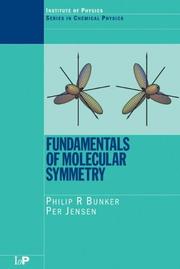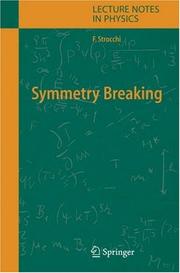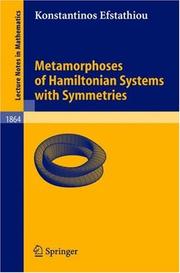| Listing 1 - 3 of 3 |
Sort by
|

ISBN: 0750309415 9780750309417 Year: 2005 Publisher: Bristol: Institute of physics,
Abstract | Keywords | Export | Availability | Bookmark
 Loading...
Loading...Choose an application
- Reference Manager
- EndNote
- RefWorks (Direct export to RefWorks)
Molecular theory. --- Symmetry (Physics) --- Group theory. --- Théorie moléculaire --- Symétrie (Physique) --- Groupes, Théorie des --- Théorie des groupes --- Théorie moléculaire --- Symétrie (Physique) --- Théorie des groupes

ISBN: 354021318X 3540315365 Year: 2005 Volume: 643 Publisher: Berlin, Heidelberg : Springer Berlin Heidelberg : Imprint: Springer,
Abstract | Keywords | Export | Availability | Bookmark
 Loading...
Loading...Choose an application
- Reference Manager
- EndNote
- RefWorks (Direct export to RefWorks)
The intriguing mechanism of spontaneous symmetry breaking is a powerful innovative idea at the basis of most of the recent developments in theoretical physics, from statistical mechanics to many-body theory to elementary particles theory; for infinitely extended systems a symmetric Hamiltonian can account for non symmetric behaviours, giving rise to non symmetric realizations of a physical system. In the first part of this book, devoted to classical field theory, such a mechanism is explained in terms of the occurrence of disjoint sectors and their stability properties and of an improved version of the Noether theorem. For infinitely extended quantum systems, discussed in the second part, the mechanism is related to the occurrence of disjoint pure phases and characterized by a symmetry breaking order parameter, for which non perturbative criteria are discussed, following Wightman, and contrasted with the standard Goldstone perturbative strategy. The Goldstone theorem is discussed with a critical look at the hypotheses that emphasizes the crucial role of the dynamical delocalization induced by the interaction range. The Higgs mechanism in local gauges is explained in terms of the Gauss law constraint on the physical states. The mathematical details are kept to the minimum required to make the book accessible to students with basic knowledge of Hilbert space structures. Much of the material has not appeared in other textbooks.
Broken symmetry (Physics) --- Symétrie brisée (Physique) --- Physics. --- Quantum theory. --- Mathematical physics. --- Mathematical Methods in Physics. --- Quantum Physics. --- Mathematical and Computational Physics. --- Elementary Particles, Quantum Field Theory. --- Physics - General --- Atomic Physics --- Physics --- Physical Sciences & Mathematics --- Symétrie brisée (Physique) --- EPUB-LIV-FT SPRINGER-B --- Physical mathematics --- Quantum dynamics --- Quantum mechanics --- Quantum physics --- Natural philosophy --- Philosophy, Natural --- Symmetry breaking (Physics) --- Mathematics --- Quantum physics. --- Elementary particles (Physics). --- Quantum field theory. --- Theoretical, Mathematical and Computational Physics. --- Mechanics --- Thermodynamics --- Physical sciences --- Dynamics --- Relativistic quantum field theory --- Field theory (Physics) --- Quantum theory --- Relativity (Physics) --- Elementary particles (Physics) --- High energy physics --- Nuclear particles --- Nucleons --- Nuclear physics --- Particles (Nuclear physics)

ISBN: 9783540243168 354024316X 3540315500 Year: 2005 Publisher: Berlin, Heidelberg : Springer Berlin Heidelberg : Imprint: Springer,
Abstract | Keywords | Export | Availability | Bookmark
 Loading...
Loading...Choose an application
- Reference Manager
- EndNote
- RefWorks (Direct export to RefWorks)
Modern notions and important tools of classical mechanics are used in the study of concrete examples that model physically significant molecular and atomic systems. The parametric nature of these examples leads naturally to the study of the major qualitative changes of such systems (metamorphoses) as the parameters are varied. The symmetries of these systems, discrete or continuous, exact or approximate, are used to simplify the problem through a number of mathematical tools and techniques like normalization and reduction. The book moves gradually from finding relative equilibria using symmetry, to the Hamiltonian Hopf bifurcation and its relation to monodromy and, finally, to generalizations of monodromy.
Hamiltonian systems. --- Symmetry. --- Nonlinear mechanics. --- Systèmes hamiltoniens --- Symétrie --- Mécanique non linéaire --- Physics. --- Topological Groups. --- Differentiable dynamical systems. --- Mathematical physics. --- Engineering. --- Mathematical and Computational Physics. --- Complexity. --- Dynamical Systems and Ergodic Theory. --- Topological Groups, Lie Groups. --- Hamiltonian systems --- Symmetry --- Nonlinear mechanics --- Mathematical Theory --- Applied Physics --- Engineering & Applied Sciences --- Mathematics --- Physical Sciences & Mathematics --- Mechanics, Nonlinear --- Hamiltonian dynamical systems --- Systems, Hamiltonian --- Construction --- Physical mathematics --- Physics --- Differential dynamical systems --- Dynamical systems, Differentiable --- Dynamics, Differentiable --- Groups, Topological --- Natural philosophy --- Philosophy, Natural --- Topological groups. --- Lie groups. --- Dynamics. --- Ergodic theory. --- System theory. --- Theoretical, Mathematical and Computational Physics. --- Complex Systems. --- Statistical Physics and Dynamical Systems. --- Physical sciences --- Dynamics --- Systems, Theory of --- Systems science --- Science --- Ergodic transformations --- Continuous groups --- Mathematical physics --- Measure theory --- Transformations (Mathematics) --- Dynamical systems --- Kinetics --- Mechanics, Analytic --- Force and energy --- Mechanics --- Statics --- Groups, Lie --- Lie algebras --- Symmetric spaces --- Topological groups --- Philosophy --- Statistical physics. --- Mathematical statistics --- Differential equations --- Global analysis (Mathematics) --- Topological dynamics --- Statistical methods --- Spectral theory (Mathematics) --- Functional analysis --- Hilbert space --- Dynamical systems.
| Listing 1 - 3 of 3 |
Sort by
|

 Search
Search Feedback
Feedback About UniCat
About UniCat  Help
Help News
News